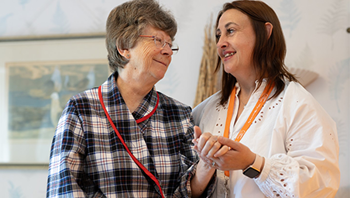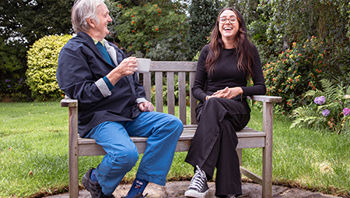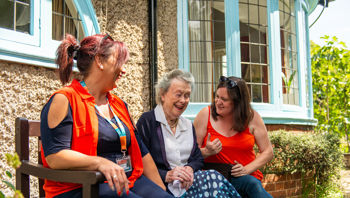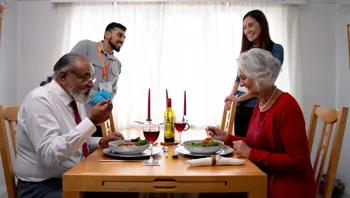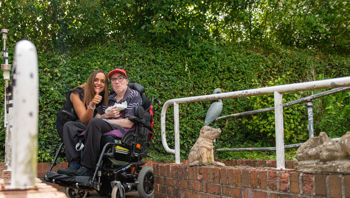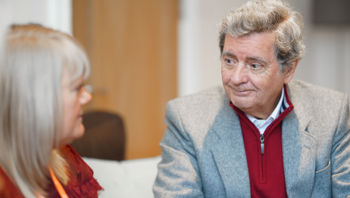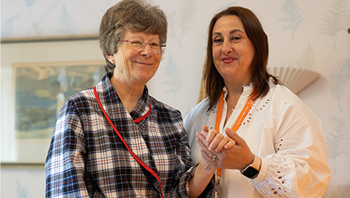What is a Stroke? Symptoms, Causes and Types
Right at Home provide Stroke after care and can help support Stroke survivors at home
Published: 11/04/2024

What is a Stroke?
A stroke is dangerous and can be life-threatening, especially if left untreated. If you suspect someone is having a stroke, you should call 999 immediately and ask for an ambulance.
What are the Symptoms of a Stroke?
Remember the main symptoms of a stroke by using the acronym F.A.S.T.
- Face – their face may have dropped on one side, the person may not be able to smile, or their mouth or eye may have dropped.
- Arms – the person with a suspected stroke may not be able to lift both arms and keep them there because of weakness or numbness in one arm.
- Speech – their speech may be slurred or garbled, or the person may not be able to talk at all despite appearing awake; they may also have problems understanding what you're saying to them.
- Time – it's time to dial 999 immediately if you see any of these signs or symptoms.
What are the Causes of a Stroke?
Like all organs, to function effectively, the brain needs the oxygen and nutrients which is provided by our blood.
If the blood supply is restricted or stopped, brain cells start dying. This can lead to brain injury, disability and possibly death.
The most common types of Strokes are:
- Ischaemic – where the blood supply is stopped because of a blood clot, accounting for 85% of all cases
- Haemorrhagic – where a weakened blood vessel supplying the brain bursts
There's also a related condition called a Transient Ischaemic Attack (TIA), where the blood supply to the brain is temporarily interrupted.
This causes what's known as a mini-stroke. It can last a few minutes or persist for up to 24 hours.
TIAs should be treated urgently, as they're often a warning sign you're at risk of having a full stroke in the near future.
Certain conditions increase the risk of having a stroke, including:
- High Blood Pressure (hypertension)
- High Cholesterol
- Irregular Heartbeats (Atrial Fibrillation)
- Diabetes
It's even more important to watch out for symptoms if you have any of these and for those around you to be aware of them and what to do.
How Can Right at Home Help Following a Stroke?
Life after a stroke varies greatly from person to person, with many individuals experiencing some level of recovery during their hospital stay. However, the journey continues at a slower pace once they return home, often following a tailored rehabilitation program crafted by the specialized stroke recovery team.
At Right at Home, we provide essential support for individuals recovering from strokes, enabling them to maintain independence in their own homes. Our services encompass assistance with mobility, continence care, medication management, household tasks, transportation, and shopping. Moreover, we prioritize aiding clients in maintaining exercise routines and embracing healthy lifestyles, crucial elements in the recovery process.
The aftermath of a stroke entails a lengthy period of adaptation and rehabilitation, during which our team assists clients in relearning old skills and potentially acquiring new ones. Throughout this journey, our overarching goal is to enhance our clients' independence and facilitate their return to normalcy, ensuring they can navigate life after stroke with confidence and support.
Right at Home Solent Services
What to Expect After a Stroke
If you have had a stroke, you can regain your independence. However, some problems may continue:
- Paralysis (inability to move some parts of the body), weakness, or both on one side of the body.
- Trouble with thinking, awareness, attention, learning, judgment, and memory
- Neuro Fatigue.
- Problems understanding or forming speech.
- Finding it hard to control or express emotions.
- Numbness or strange sensations.
- Pain in the hands and feet that worsens with movement and temperature changes.
- Trouble with chewing and swallowing.
- Problems with bladder and bowel control.
- Depression.
Useful Rescources for Stroke Survivors
https://shorturl.at/sxSVZ - Life After Stroke Services from the Stroke Association.
https://www.nhs.uk/conditions/stroke/recovery/ - NHS Stroke Recovery.

How Can Home Care Support Stroke Survivors?
Most people will need some support following a stroke. The weeks and months after a stroke is the fastest recovery period, but this can continue for years, and there is no set time limit. Support or care a stroke survivor may require can take many forms and can include practical help with shopping, cooking or taking medication. It can also mean emotional support such as regular chats, helping to fill out forms, helping with communication such as reading or writing and supporting them to manage anxiety or memory problems. This care and support will often fall on a friend or family member, impacting their life emotionally, financially and physically.
This is where Home Care comes in. Home Care could be used to support the Stroke Survivor and/or the unpaid carer, depending on the level of care they require. Respite care can reduce stress for the primary CareGiver and family, often leading to better patience and well-being. Home respite care can alleviate frustration and exhaustion and offers the person receiving care valuable interaction with other people. It also provides a fresh set of eyes; daily routines can become stale, but the respite carer might be able to offer advice to help breathe renewed energy into the role of CareGiver.
Care at Home - Contact Us
If you would like to find out more information, get in touch with a member of our friendly team on 01329 233755 or 02380 170205. We offer a free Care Assessment with no obligation to discuss how we can support you. This also gives you time to express any concerns and ask any questions.
